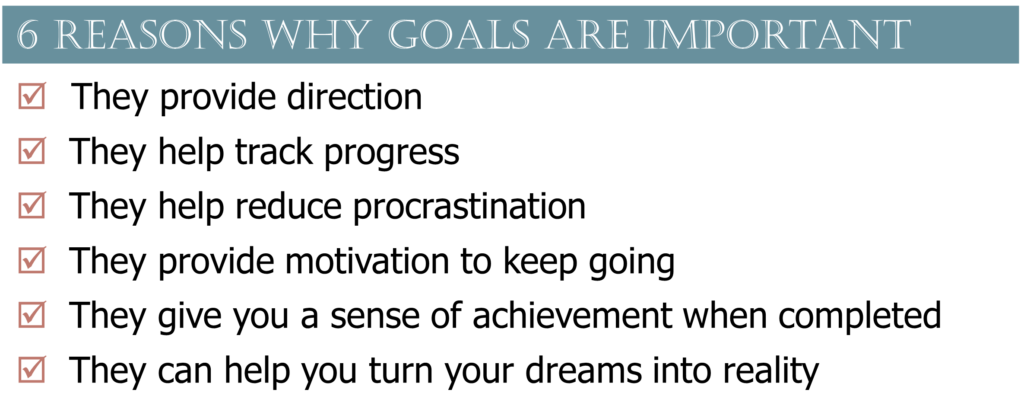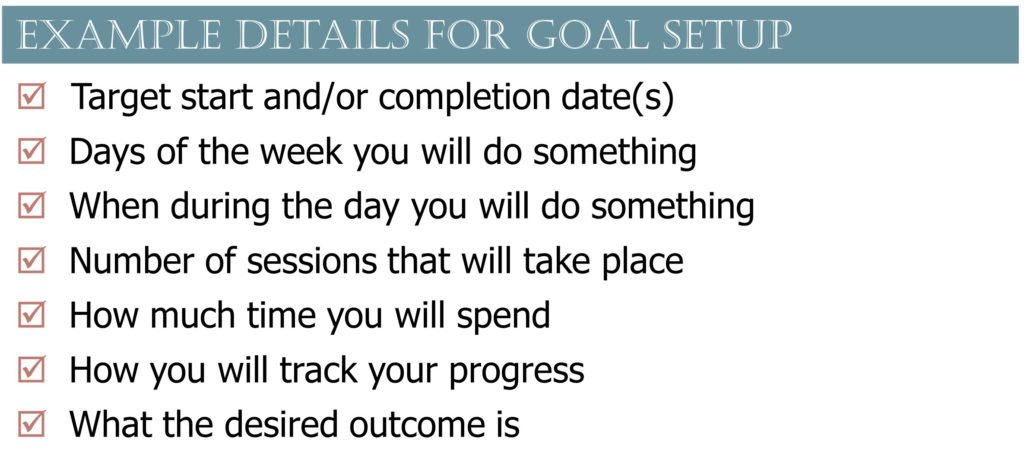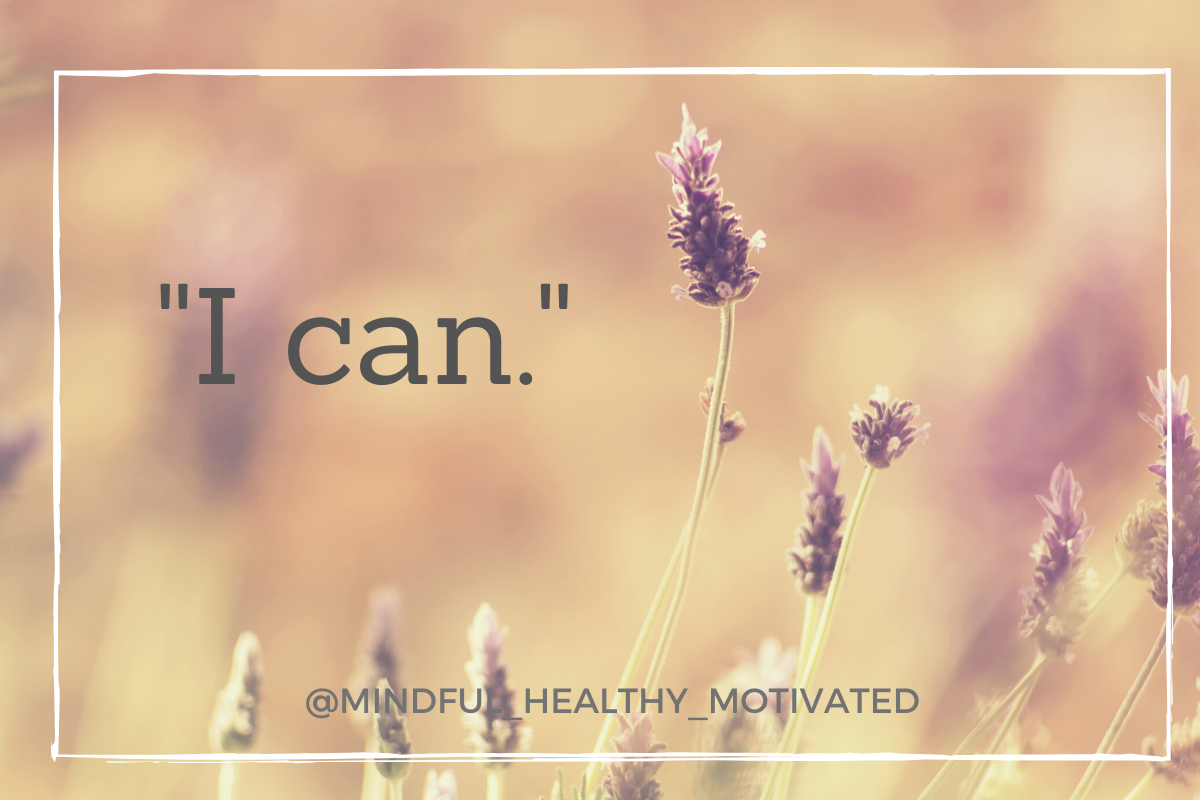
6 Reasons Goals are Important and Setup Tips for Success
My 6 Reasons Goals are Important
What are Goals?
Let’s talk about goals. What are they exactly? Well, technically, they can be different things to different people such as a new milestone in life, getting a promotion at work, hitting a new personal record in your workouts, or simply getting the laundry folded on the same day you washed it.. for once.
The great thing about goals is that they can be tailored to everyone’s individual needs, wants, and desires. They can be as elaborate and complex or as simple and streamlined as you want them to be. Don’t be afraid to dream big! But remember that simple goals are great to have as well.
Goals are something to be achieved. They give us a target for what we want to accomplish.
I recently found myself feeling a bit lost on some projects I was working on, and realized I didn’t have clear goals outlined for them. As I was creating those goals, I ended up on here writing an article about why I love goal setting. So I thought I’d share 6 reasons I find having goals to be important, and tips on how to best set them up in order to make them work for you.
By not having goals it can feel like we are simply existing and going through the daily motions without any real sense of where we are headed. And I have been in that position many times. Feeling like I was just making it through each day with vague, long-term goals that I never seemed to get any closer to. Now, that doesn’t mean I wasn’t having fun, or spending time with friends and family or enjoying my life necessarily. But I wasn’t going anywhere.
Once I started setting goals for myself, both big and small, the changes started happening. I started seeing the differences I could make in my life by having a sense of direction and outlining the steps to take in order to make those goals become a reality. Below are my six reasons why I find goals to be important for everyone to have.

Simple Goals
As I mentioned, your goals don’t always have to be elaborate, long-term dreams you want to achieve. They can be simple quick hits, such as knocking items off your to-do list.
Wait, what? You’re probably thinking “my to-do list is full of chores/errands/housework/etc., those aren’t goals.”
Or are they? Hear me out with a change of perspective.
Think of your to-do list as goals rather than chores. The word “chore” promotes negative feelings towards the act of getting the item done. Instead, think of those items as goals that have positive outcomes once completed. A shift in your perspective goes a long way toward changing how you feel about things in your everyday life.
Examples:
- My goal is to get this laundry done today so that instead of having a pile of clothes in the corner, my room will be clean.
- My goal is to organize my closet/pantry/garage, etc. over this weekend. Clearing up the clutter will make it so much easier for me to find the things I need.
- My goal is to prep food for the next few days. This will make meals easier to put together and help me stick to my eating style.
Let’s be real, completing some goals may not necessarily be fun while you’re doing them. Even in pursuit of exciting goals, there will be steps along the way that may not thrill you, but will be necessary to complete. By focusing on the positive outcome instead of the action involved, you can reframe your perspective and make these tasks easier to tackle.
I find even completing simple goals gives me a sense of achievement. This then leads to more motivation to continue making progress. And I can apply that motivation toward going after my larger goals, too.
Goal Setup Tips
Create Sub-Goals
If you have a complex or long-term goal, you’ll want to outline the necessary sub-goals to help you achieve success. These sub-goals are the incremental steps, or milestones, that need to be completed between where you’re starting and where you want to end up. If you’re only looking at the big picture or the end goal, it’s easy to get overwhelmed and give up. Or even worse, to never start at all.
As you saw at the beginning of this post, one of my more recent long-term goals was to move to another state. I wanted a new environment with cooler weather, more seasonal change, and mountains. I had dreamt of this for a long time, but never really buckled down on tackling the sub-goals that I needed to complete in order to make this dream a reality.
Once I did, the change happened very quickly, and I was knocking stuff off my list like a champ.
Setup your sub-goals in the same way as you would your other goals by following the info below.
Be Detailed
Make goals specific by giving them key details such as start and/or completion dates, for example. General ideas are difficult to qualify as having been accomplished.
This, for me, is the most important part of goal setting. The more detailed I can be with my goals, the more direction I have on what I need to do in order to accomplish them.
Example: If your goal is “I’m going to start exercising more”, that’s a great idea, but what does this goal REALLY mean in terms of how you plan to accomplish it? Are you planning to join a gym or workout at home? How often do you plan to workout, what types of exercise, how long will each session be, etc? Sure, you could start by throwing together some different weights or cardio exercises you’re familiar with. But without a plan, there’s a good chance you’ll end up losing that momentum because you don’t have the specific details to hold yourself accountable.
So instead of a general statement such as “I’m going to start exercising more”, change that to “I’m going to walk for 30 mins after work on Mondays, Wednesdays, and Fridays starting this coming Monday”.
A detailed goal like this tells you:
- The type of exercise you plan to do
- How long you plan to workout
- The timeframe during the day you plan to workout in
- The days of the week this will happen
- When you are going to put this goal into action
With details involved, you can easily determine your progress and hold yourself accountable to stick with it.

Use details like these in your sub-goals as well. So start by outlining your long-term goal using the details that apply to it. Then create sub-goals for all the steps in between now and where you will be once you accomplish your long-term goal. Give each sub-goal its own details that are specific to completing them.
By defining each step, you can keep yourself on track and eliminate the stress of finding yourself two days before the target completion date of your long-term goal only to realize you’ve done nothing to get started. Been there, done that.. wayyyy too many times!
Be Realistic
Understand that changes don’t happen overnight. Sure, some simple goals – like crossing things off your to-do list – can be accomplished in the same day you decide to do them. But many goals will take days, months, or even years to accomplish.
So when you assign the details to each step of your goal, be realistic in what you are working to achieve. It’s easy to over anticipate our capacity to get things done or adopt a new schedule. Use caution to avoid over exerting yourself with a tough schedule, or you may risk burning out and falling off track.
Know When to be Flexible
Finally, it’s important to remain flexible enough to change course, if the need arises. Depending on your situation, that flexibility may range from minor adjustments to your current goal or it could be a complete pivot in another direction.
Let me be clear, I am all for being driven to accomplish the goals you set up for yourself. At the same time, don’t be so hyper focused on a particular goal that you fail to realize when you need to make a change.
Making an adjustment doesn’t have to equal giving up on your goal. It may simply be a shift to a different form of the same goal that leads to a better outcome for you.
I’ve had to be practice this many times. Yes, sometimes it has meant stopping one course of action to pursue another. But every time the change has been for the better because I realized that as circumstances in my life shifted, the course I was on wasn’t going to be the best for me.
So I had to be flexible.
I did this with a large goal of mine which was originally to become a Registered Dietitian (RD). I went back to school for a degree in nutrition and dietetics, graduated with awesome grades… and then some things in life changed. I had to really take stock of what was going on and realized going the RD route wasn’t going to be the best option for what I wanted to achieve in the long run. So, I pivoted my direction to one I felt was better. I’m still focused on doing nutrition-related work, just with a different end goal. And I feel I am on a much better path for myself than what I had originally planned.
So that’s my take on goal setting and why I find it to be important as well as some tips I use when creating goals for myself. I know there are a number of different views on goals, so if you have some great tips or reasons you find goal setting important, I’d love to read them in the comments below. Have a great day and talk to you soon! Bye!
[optin-monster slug=”itv08rrqv4nfcjlwizw5″]


